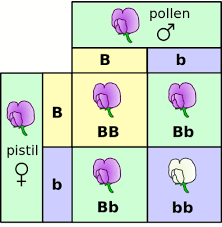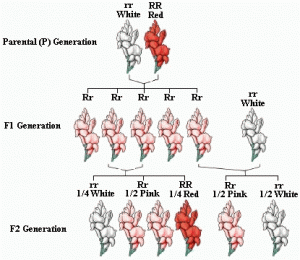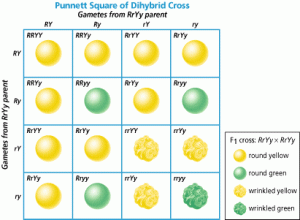Mendel crossed purple flowers (peas) with white flowers (peas) and he got purple flowers for all of the first generation. Now we should know that the first cross in any genetic cross is called the P cross or the parental cross and then the offspring’s of that are called the F1 or filial 1. When he crossed these purple flowers with themselves, what he got was a 3 to 1 ratio of purple to white flowers peas (just as a crystal white as that first white was in the beginning). And so what he said was that there was a character or trait that was passed through, and for purple flowers this character could be PP and for the white flowers it could be pp so all of F1 generation will be Pp .
1)Segregation:If we have a gene type Pp the probability of P an p is 50%. This separation of genes is called segregation. (random chance of having P or p)
2) Independent assortment: That means the separation of genotypes do not influence each other, so they are independent (But sometimes it is not true because two genes are at same chromosomes).
Problems:
1) A coin is flipped 4 times and comes up heads each time. What is the probability that the next coin flip will come up heads?
2) Classify the following as heterozygous or homozygous: RR, Rr, YY, Yy RR
3)What is the phenotype of the following Yy, Rr, yy, YyRr
4)What is the probability of Rr X Rr producing wrinkled seeds?
5)What is the probability of Yy X yy producing green seeds?
6)What is the probability that Rr Yy X RR Yy would produce Rr Yy?
Punnett square
The Punnett square is often over used as just a quick way to solve genetic problems without really understanding it. What’s ‘going on with the genetics? The two sides of Punnett square represent the alternatives after meiosis. In other words you have a brunch of genes and you give half of those genes to a sperm or an egg. And that happens trough meiosis and so the organization of those gametes. In this case it’s just a monohybrid cross, are going to be on either side of this, just like a flip of a coin. This would be for one parent. And then this would be the other parent on the other side. And so what are in boxes on a Punnett square stand for? They simply stand for all the alternatives that could occur if we had mating between each of these different gametes. And so let’s get to some examples and hopefully that will help. So, we are going to start with a monohybrid cross. A monohybrid cross is simply a cross that is looking at one trait. And so let’s say were crossing purple flowers that are homozygous purple with those that are homozygous white flowers. In other words this is the dominant trait and the other one is a recessive trait. And so if you look, at the parents what you Want to do first of all, is figure out what are the possible gametes. That could be produced in meiosis. What does it mean? It can only give one thing, it can only give a big P or that dominant allele. And so if you’re doing a problem like this you don’t need a big Punnett square. The other parent is pp and he can give only a p because the p’s are the same.
We see that there are two possibilities for each parent. And we have to show both of those possible gametes of meiosis. There is a 1 to 2 genotypic ratio PP,pp-homo and Pp,Pp-hetero But a 3 to 1 ratio for phenotype, that means three purple to 1 white. Now let’s see an incomplete dominance; a snapdragon would be an example of that. A snapdragon has two genes; if it has a red gene and a white gene, then it’s going to be pink. And so this one, in this case we will have 1 to 2 ratio in genotype but also in phenotype (co dominance or incomplete dominance)
And now we will try with a sex linked chromosomes or a x linked chromosomes. Ex: is a color blindness gene and the father is normal.
| X | Y | |
| X | XX | XY |
She is not color blind because she has an efficient gene and she is only carrier. So we have a color blind male and a carrier female, a normal female and a normal male.
Now let’s have a look on dihybrid cross Rr Yy Rr Yy, R= round pea seeds Y=yellow seeds If it is recessive that stands for wrinkled and if it is a little y that stands for green and so we are looking at a dihybrid, so that means two traits. We’re looking at seed’s shape (round or wrinkled). And seed’s color, yellow or green. So now we have to do a dihybrid cross. And so the tendency is we look at this parent. We can see that there are four letters and there are four boxes and then you just simply write them out. Big R little r, big Y little y and then you get a weird answer and you don’t know what to do with it. Rr Yy What are possibility of gametes? RY, Ry, rY, ry We can do the same with other parent
These nine will be round and yellow, because they are dominant and when we have dominant genotype the phenotype will be the same (round and yellow); four will be (wrinkled and yellow) and one will be green and wrinkled.
Human genetic disorders: Human genetic disorders caused by non-disjunction: Trisomy 21 (Down’s syndrome) ,klinefelters’s syndrome , Xxx metafemals syndrome. Can we survive with only one x or y chromosome? so we will study specific diseases
1) Sickle cell anemia which is a genetic blood disorder (a base substation in a single point). It causes red blood cells to be misshapen. This abnormality is frequent in Africa and Mediterranean regions and in south and central America (where malaria have been prevalent) The alleles for this trait exhibit co-dominance Bn=normal Bs=sickle
| genotype | phenotype |
| BnBn | N |
| BnBs | Normal and sickle cells(sickle trait) |
| BsBs | Sickle cell anemia |
With sickle trait the people have no abnormal episode and it is a good defense against malaria.
2) Huntington’s disease, a genetic disorder du to an abnormal gene on chromosome n° 4. The faulty gene that causes Huntington’s disease is found ( a normal copy of the gene produces huntingtin, a protein. The faulty gene is larger than it should be and produces a larger form of huntingtin)
Some of our brain cells are sensitive to the larger form of huntingtin – it undermines their function and eventually destroys them. Scientists are not sure exactly how this happens. Scientists have figured out why a faulty protein accumulates in cells everywhere in the bodies of people with Huntington’s disease, but only kills cells in the part of the brain that controls movement, causing negligible damage to tissues elsewhere. Huntington disease is unique because it is a dominant gene (dominant genes don’t have to be common in fact and Huntington is really rare ) Why this disease is interesting? If the gene is dominant and the patient dye, how can he passe the gene to the others? The Huntington disease dose not become symptomatique until age 40; so the patient will have time to passe the gene.
3) Hemophilia: The gene for Haemophilia is carried on the X sex chromosome (females are XX; males are XY). A man with Haemophilia passes the faulty gene to his daughters who then carry this gene and may pass the condition onto their sons. A man with Haemophilia does not pass the faulty gene onto his sons because they receive a copy of his Y chromosome (their X chromosome comes from the mother).
Men are affected because the faulty gene on their X chromosome lacks the necessary instructions to produce the clotting factor which causes blood to clot. Women are usually unaffected because they have two X chromosomes and the working copy of the gene tends to override the faulty copy. However, about a third of female carriers have low clotting factor levels and may be mildly affected.
If a carrier mother decides to have children, all her daughters have a 50% (1 in 2) chance of being a carrier. This depends on whether they receive the X chromosome containing the faulty or the working gene. Sons also have a 50% (1 in 2) chance of inheriting the faulty or the working gene. If they inherit the faulty gene, they will have Haemophilia as they do not have a second X chromosome to override the faulty copy.
About 30% of people with the condition have no family history of Haemophilia. They are probably affected because of a spontaneous genetic mutation which took place in the egg or sperm before fertilisation.



